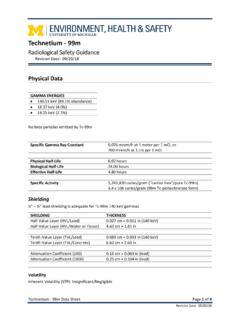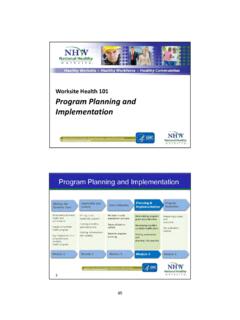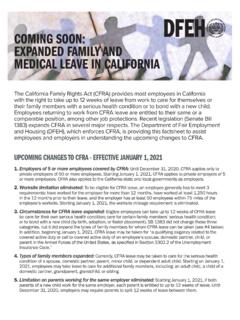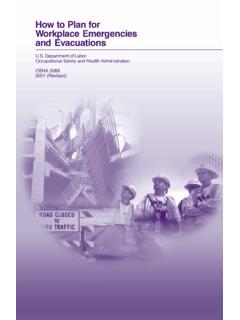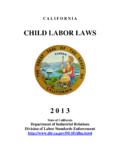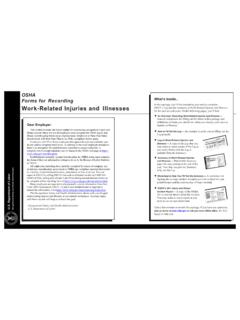Transcription of CONSTRUCTION SAFETY REQUIREMENTS - University of …
1 N T HE U N I V E R S I T Y O F M I C H I G A N ARCHITECTURE, ENGINEERING AND CONSTRUCTION OCCUPATIONAL SAFETY & ENVIRONMENTAL HEALTH CONSTRUCTION SAFETY REQUIREMENTS January 2010 (Revised 1/3/12) Contents I. DEFINITIONS .. 3 II. INTRODUCTION .. 4 III. SAFETY MANAGEMENT SYSTEM .. 5 A. Contractor Prequalification .. 5 B. Contractor SAFETY Representatives .. 6 C. Monthly SAFETY Reports .. 7 D. Communication .. 7 E. Job SAFETY Board .. 8 F. Project-Specific SAFETY Plan Overview .. 8 IV. University ADDITIONS FOR PROJECT-SPECIFIC SAFETY 10 A. Accountability Plan .. 10 B. Audits/Inspections .. 10 C. Cell Phone Usage .. 10 D. Crane SAFETY and Rigging .. 10 E. Electric Temporary.
2 12 F. Emergency Action Plan .. 12 G. Envir onmental Health and SAFETY .. 13 H. Equipment SAFETY .. 15 I. Fall Protection .. 15 J. Fire Prevention and Protection .. 16 K. Housekeeping .. 17 L. Job Hazard Analysis (JHA) .. 18 M. Personal Protective Equipment (PPE) .. 18 N. Potentially hazardous exhaust systems .. 19 O. Protection of the Public .. 19 P. Recordkeeping and Incident Reporting .. 19 Q. Rooftop Access .. 20 R. Smoking .. 20 S. Substance Abuse Policy .. 20 T. Temporary Elevators .. 21 U. Utility Tunnel SAFETY .. 21 V. Visitors .. 21 V. Summary of revisions incorporated into this January 2010 issue (Rev. 1/3/12) .. 22 VI. APPENDICES Appendix A: Monthly SAFETY Report ..23 Appendix B: SAFETY Plan Certification Form.
3 25 Appendix C: Crane - Job SAFETY Analysis Form ..26 Appendix D: Hot Work Permit ..31 Appendix E: Initial Incident Report ..32 U-M CONSTRUCTION SAFETY Requirements2 of 32 January 2010 (Rev. 1/3/12)I. DEFINITIONS General Contractor/ CONSTRUCTION Manager: The party named in the contract agreement who will execute the Work and who shall be responsible for the proper completion of the Project. DART: Days Away from Work, Restriction of duty, or Transfer. This term is used by MIOSHA and the Bureau of Labor Statistics for tracking and reporting of these types of injuries. Document: University of Michigan CONSTRUCTION SAFETY REQUIREMENTS . EMR: Worker s Compensation Experience Modification Rate. Hazardous Materials: Any pollutant, hazardous or toxic substance, waste or material, including oil products, mold, asbestos, asbestos-containing materials, lead, lead-containing materials, urea formaldehyde foam insulation, transformers or other equipment which contains dielectric fluid -containing polychlorinated biphenyls, flammable explosives, radioactive materials or other material or substance designated or regulated as hazardous or as a toxic substance or waste, pollutant or contaminant under Regulations.
4 Job Hazard Analysis (JHA): A SAFETY analysis to be submitted by subcontractors/trade contractors prior to the commencement of work on a Project. Also known as Job SAFETY Analysis or Pre-task Analysis. MIOSHA: Michigan Occupational SAFETY and Health Administration. OSEH: The University of Michigan Occupational SAFETY and Environmental Health Department. Owner: The Regents of The University of Michigan, a Constitutional Corporation having its principal offices in Ann Arbor, Michigan, represented on the Project by the Owner s Representative. Owner s Representative: The individual designated in writing by the Owner to receive all communication under the Contract Documents and with the authority to bind the Owner with respect to decisions made and actions taken pursuant to the Contract Documents.
5 Plan/Contractor s Project-Specific SAFETY Plan: The Plan created by the Contractor pursuant to the REQUIREMENTS of its Contract with U-M outlining how the Contractor intends to address SAFETY on the Project, and meet the Contractor s responsibilities to provide a safe work environment and to aid in developing a program to eliminate accidents, injuries and property damage. It is the Contractor s responsibility to ensure compliance with all applicable MIOSHA standards. Project: The building or facility, improvement, alteration, addition or repair, the CONSTRUCTION for which is contemplated under the Contract Documents. Project Site: Those areas indicated in the Contract Documents where the Work is to be performed. This includes premises owned by U-M as described in the Contract between U-M and Contractor and/or areas contiguous thereto, including any Project Site set up by U-M for use exclusively for storage of material or equipment or for on-Project Site fabrication of material to be used on the Project Site, including temporary locations.
6 U-M CONSTRUCTION SAFETY Requirements3 of 32 January 2010 (Rev. 1/3/12)Project Team: The Owner s Representative, Architect and Contractor, together with such other persons or entities selected by the Project Team and whose management, responsibility and coll aboration are required for the Project s success. Subcontractor/Trade Contractor: Where subcontractor/trade contractors is referenced, include all trade contractors, subcontractors and lower tier subcontractors engaged to perform work on the Project. University of Michigan: References in this Document to University of Michigan , U-M , or the campus all include the entire Ann Arbor Campus, Flint Campus and Dearborn Campus, and other properties owned or controlled by University of Michigan.
7 Work: The CONSTRUCTION required by the Contract Documents whether completed or partially completed, performed by the General Contractor/ CONSTRUCTION Manager, Subcontractor/Trade Contractor, or other lower tiered subcontractors. Work refers to the furnishing of labor, furnishing and incorporating materials and equipment into the CONSTRUCTION and providing any service required by the Contract Documents to fulfill the General Contractor s/ CONSTRUCTION Manager s obligation to complete the Project. II. INTRODUCTION The University of Michigan endeavors to maintain safe working conditions for its staff and a safe and healthy environment for its students and visitors. This also includes our CONSTRUCTION contractors and their respective workforces.
8 SAFETY is an essential component of CONSTRUCTION work at the University of Michigan. It is a key contractual responsibility for those managing and performing such work and an important determinant of overall Project success. The University of Michigan believes that effective contractor SAFETY programs enhance projects by assisting contractors to systematically identify and evaluate anticipated hazards and establish controls in advance of actual work. While the obvious purpose of a contractor SAFETY program is to reduce on-the-job injuries and illnesses to the greatest extent possible and to ensure compliance with all workplace SAFETY standards, the interactions developed through these programs can also bring collateral benefits in the form of improved communication, document ation, and cost savings.
9 University of Michigan CONSTRUCTION SAFETY Goal University of Michigan s immediate goal is for contractors to work injury and illness free on each of the projects they perform at U-M. Our goal is zero accidents on CONSTRUCTION projects. Scope of Document The contractor is responsible for the SAFETY of its employees, and the University of Michigan is committed to helping the Contractor meet its goals of a safe, healthy and productive work site. The University provides this document to help contractors provide a safe environment for their employees and everyone else who visits the project site. The applicability of this document is for all CONSTRUCTION projects administered through U-M Architecture, Engineering and CONSTRUCTION (AEC).
10 The contractor nevertheless remains solely responsible for the SAFETY of all persons and property, and must take whatever steps may be necessary or appropriate to assure that SAFETY . The contractor is solely responsible for the development and implementation of their own SAFETY program. This document provides contractors with U-M s specific REQUIREMENTS for incorporation into their SAFETY programs implemented pursuant to their contracts for work to be performed at U-M. This document is not U-M CONSTRUCTION SAFETY Requirements4 of 32 January 2010 (Rev. 1/3/12)designed to address every possible environmental, SAFETY , or health issue. No specific REQUIREMENTS given herein are intended to limit, replace or supersede applicable provisions of federal, state, and municipal SAFETY laws.

